Behavior Management and Inclusive Learning Strategies Report
VerifiedAdded on 2020/10/05
|18
|4667
|248
Report
AI Summary
This report delves into the realm of behavior management and inclusive learning, commencing with an exploration of foundational theories such as Skinner's and Glaser's. It analyzes the application of these theories within educational settings, focusing on strategies to foster a safe and inclusive learning environment for diverse student populations. The report highlights practical techniques like providing varied learning resources, offering different assessment options, and promoting positive behavior through operant conditioning and positive reinforcement. It also addresses the importance of equality, diversity, and meeting the individual needs of learners, including those with special needs or disabilities. The report further examines assessment strategies, including formative, interim, and summative assessments, to monitor student progress and refine teaching methodologies. Overall, the report provides a comprehensive overview of behavior management principles and their practical application in creating effective and inclusive learning experiences.
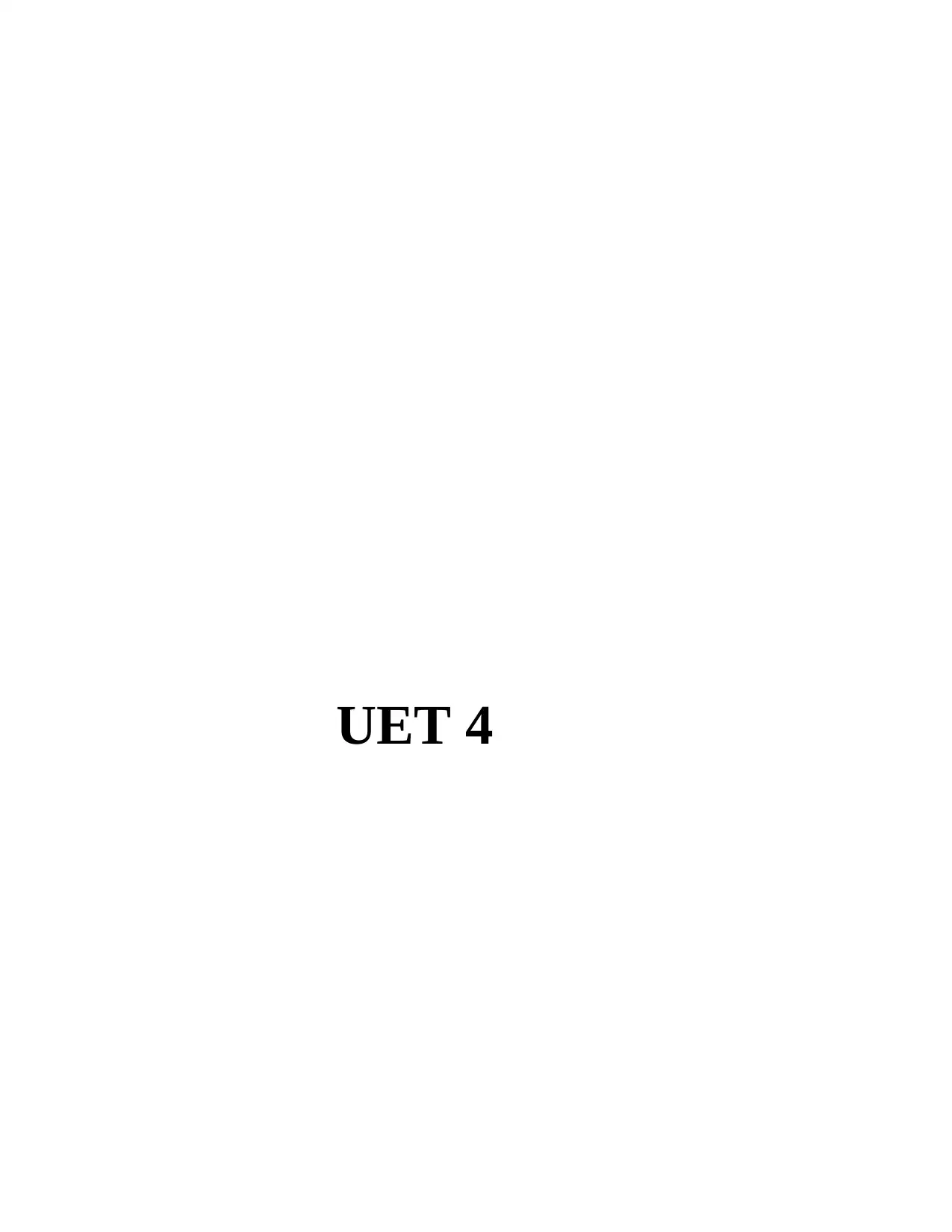
UET 4
Paraphrase This Document
Need a fresh take? Get an instant paraphrase of this document with our AI Paraphraser
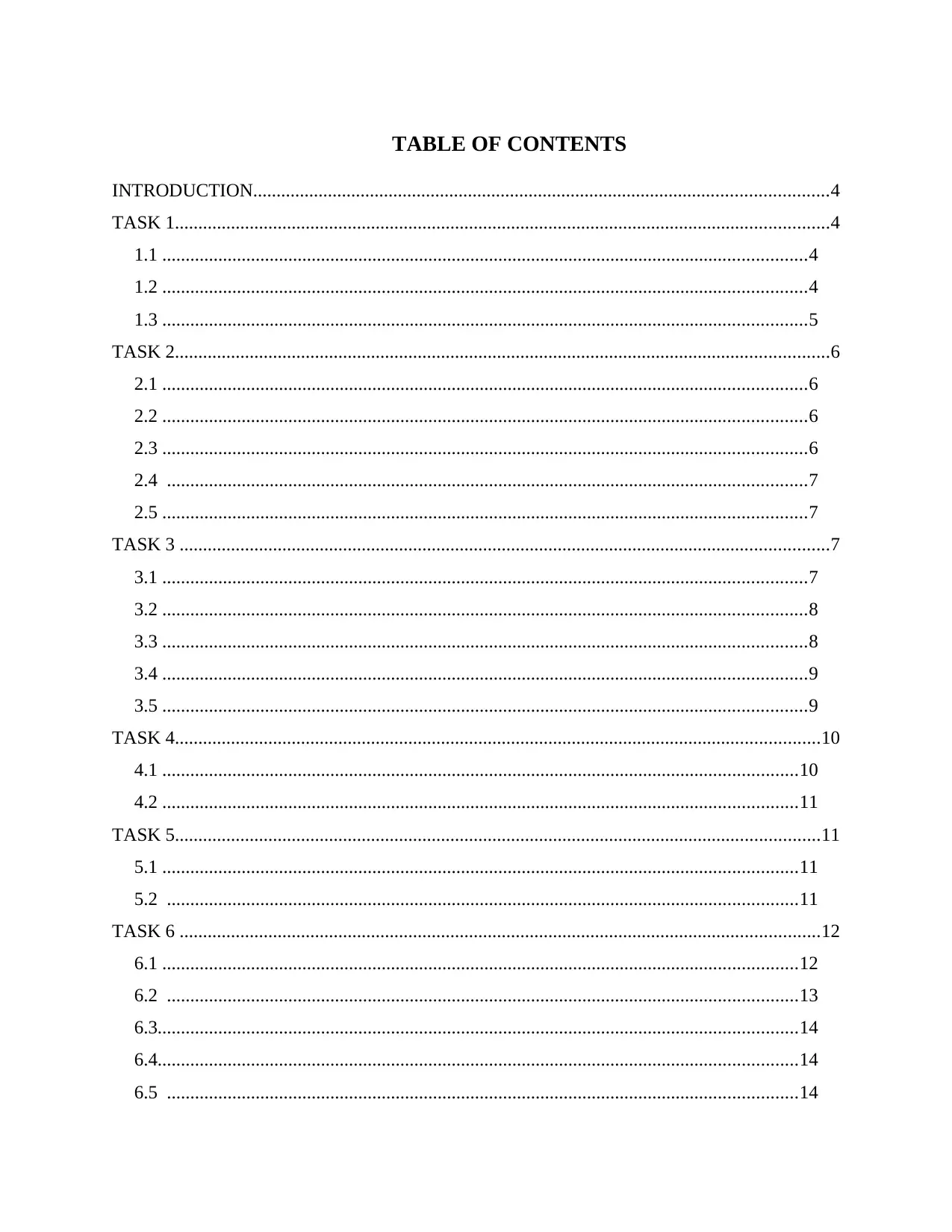
TABLE OF CONTENTS
INTRODUCTION...........................................................................................................................4
TASK 1............................................................................................................................................4
1.1 ..........................................................................................................................................4
1.2 ..........................................................................................................................................4
1.3 ..........................................................................................................................................5
TASK 2............................................................................................................................................6
2.1 ..........................................................................................................................................6
2.2 ..........................................................................................................................................6
2.3 ..........................................................................................................................................6
2.4 .........................................................................................................................................7
2.5 ..........................................................................................................................................7
TASK 3 ...........................................................................................................................................7
3.1 ..........................................................................................................................................7
3.2 ..........................................................................................................................................8
3.3 ..........................................................................................................................................8
3.4 ..........................................................................................................................................9
3.5 ..........................................................................................................................................9
TASK 4..........................................................................................................................................10
4.1 ........................................................................................................................................10
4.2 ........................................................................................................................................11
TASK 5..........................................................................................................................................11
5.1 ........................................................................................................................................11
5.2 .......................................................................................................................................11
TASK 6 .........................................................................................................................................12
6.1 ........................................................................................................................................12
6.2 .......................................................................................................................................13
6.3.........................................................................................................................................14
6.4.........................................................................................................................................14
6.5 .......................................................................................................................................14
INTRODUCTION...........................................................................................................................4
TASK 1............................................................................................................................................4
1.1 ..........................................................................................................................................4
1.2 ..........................................................................................................................................4
1.3 ..........................................................................................................................................5
TASK 2............................................................................................................................................6
2.1 ..........................................................................................................................................6
2.2 ..........................................................................................................................................6
2.3 ..........................................................................................................................................6
2.4 .........................................................................................................................................7
2.5 ..........................................................................................................................................7
TASK 3 ...........................................................................................................................................7
3.1 ..........................................................................................................................................7
3.2 ..........................................................................................................................................8
3.3 ..........................................................................................................................................8
3.4 ..........................................................................................................................................9
3.5 ..........................................................................................................................................9
TASK 4..........................................................................................................................................10
4.1 ........................................................................................................................................10
4.2 ........................................................................................................................................11
TASK 5..........................................................................................................................................11
5.1 ........................................................................................................................................11
5.2 .......................................................................................................................................11
TASK 6 .........................................................................................................................................12
6.1 ........................................................................................................................................12
6.2 .......................................................................................................................................13
6.3.........................................................................................................................................14
6.4.........................................................................................................................................14
6.5 .......................................................................................................................................14
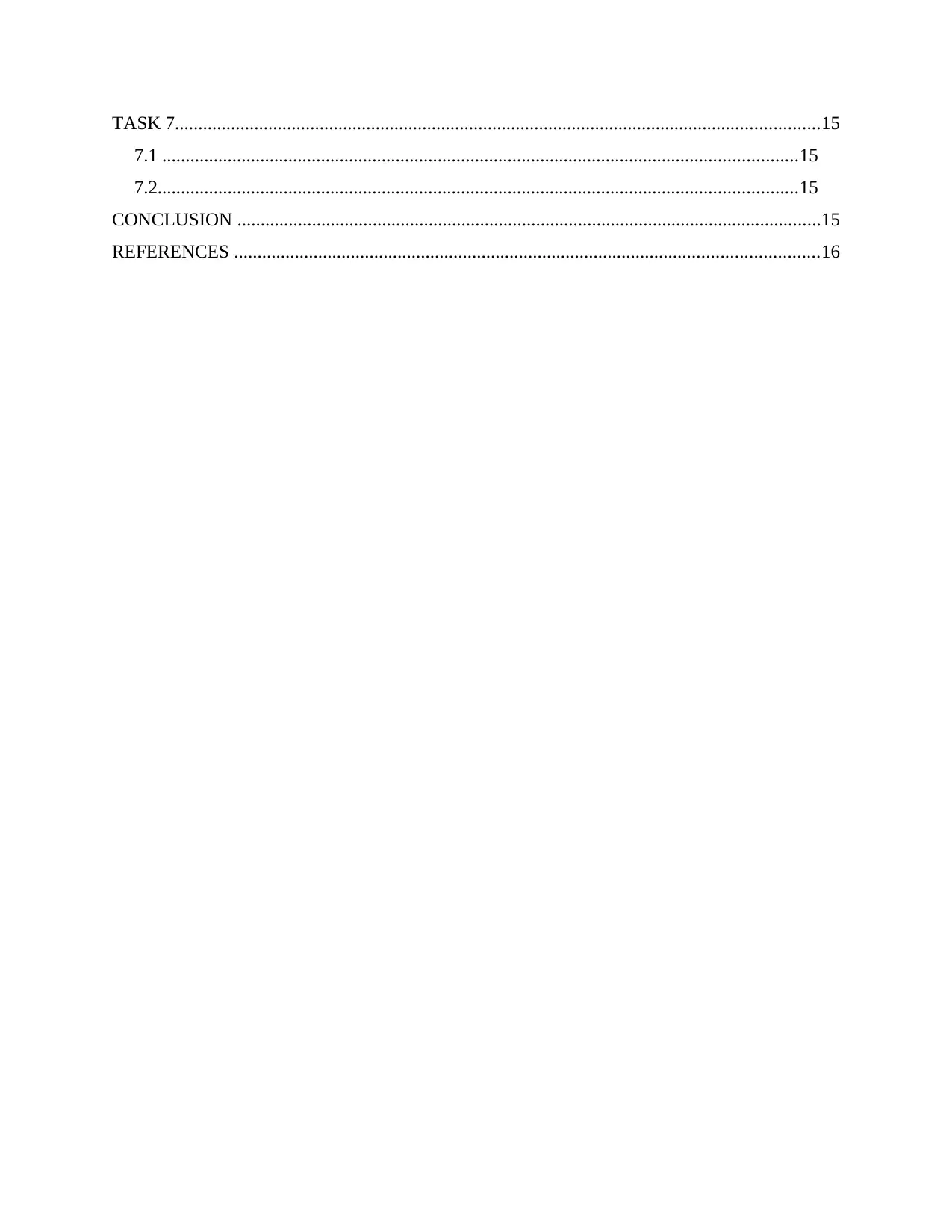
TASK 7..........................................................................................................................................15
7.1 ........................................................................................................................................15
7.2.........................................................................................................................................15
CONCLUSION .............................................................................................................................15
REFERENCES .............................................................................................................................16
7.1 ........................................................................................................................................15
7.2.........................................................................................................................................15
CONCLUSION .............................................................................................................................15
REFERENCES .............................................................................................................................16
⊘ This is a preview!⊘
Do you want full access?
Subscribe today to unlock all pages.

Trusted by 1+ million students worldwide
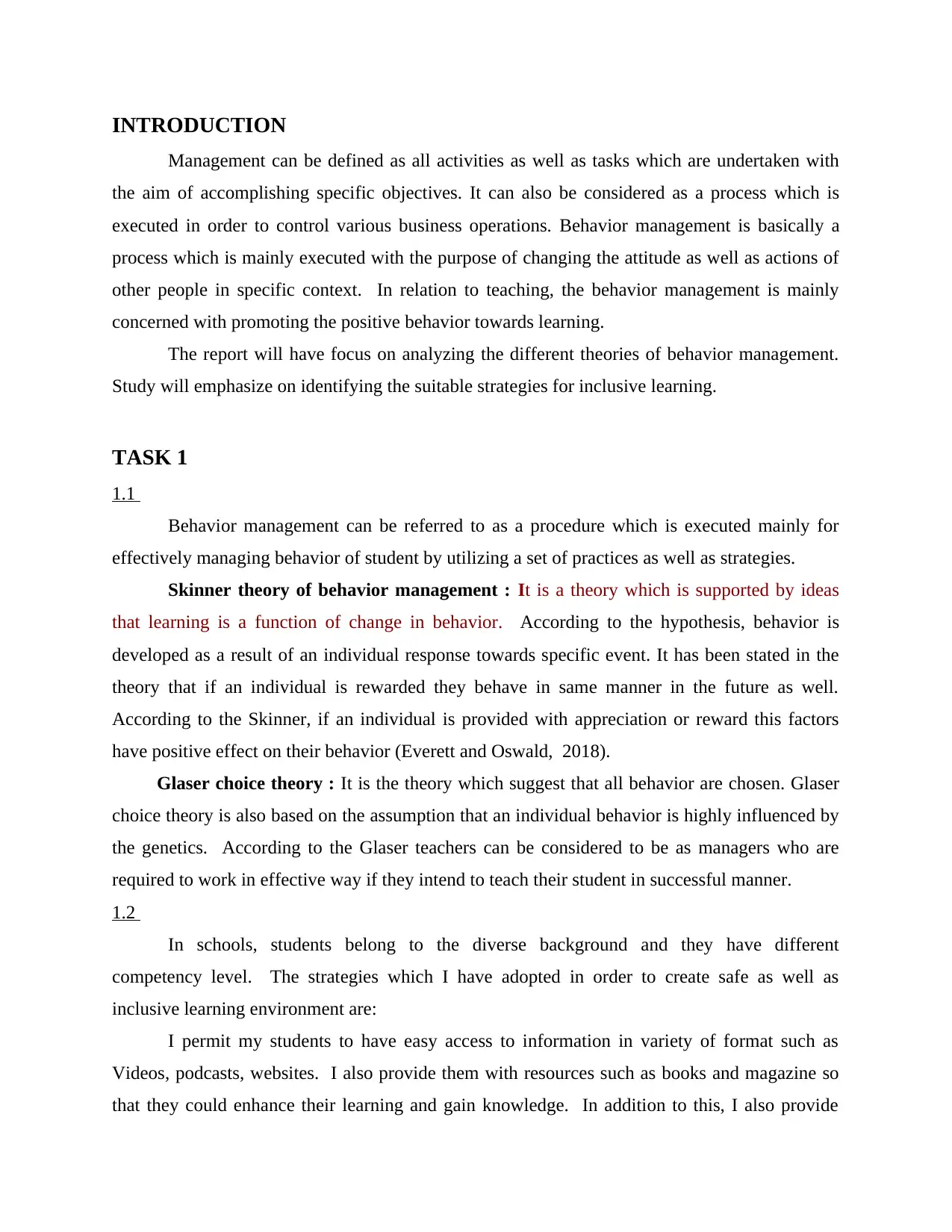
INTRODUCTION
Management can be defined as all activities as well as tasks which are undertaken with
the aim of accomplishing specific objectives. It can also be considered as a process which is
executed in order to control various business operations. Behavior management is basically a
process which is mainly executed with the purpose of changing the attitude as well as actions of
other people in specific context. In relation to teaching, the behavior management is mainly
concerned with promoting the positive behavior towards learning.
The report will have focus on analyzing the different theories of behavior management.
Study will emphasize on identifying the suitable strategies for inclusive learning.
TASK 1
1.1
Behavior management can be referred to as a procedure which is executed mainly for
effectively managing behavior of student by utilizing a set of practices as well as strategies.
Skinner theory of behavior management : It is a theory which is supported by ideas
that learning is a function of change in behavior. According to the hypothesis, behavior is
developed as a result of an individual response towards specific event. It has been stated in the
theory that if an individual is rewarded they behave in same manner in the future as well.
According to the Skinner, if an individual is provided with appreciation or reward this factors
have positive effect on their behavior (Everett and Oswald, 2018).
Glaser choice theory : It is the theory which suggest that all behavior are chosen. Glaser
choice theory is also based on the assumption that an individual behavior is highly influenced by
the genetics. According to the Glaser teachers can be considered to be as managers who are
required to work in effective way if they intend to teach their student in successful manner.
1.2
In schools, students belong to the diverse background and they have different
competency level. The strategies which I have adopted in order to create safe as well as
inclusive learning environment are:
I permit my students to have easy access to information in variety of format such as
Videos, podcasts, websites. I also provide them with resources such as books and magazine so
that they could enhance their learning and gain knowledge. In addition to this, I also provide
Management can be defined as all activities as well as tasks which are undertaken with
the aim of accomplishing specific objectives. It can also be considered as a process which is
executed in order to control various business operations. Behavior management is basically a
process which is mainly executed with the purpose of changing the attitude as well as actions of
other people in specific context. In relation to teaching, the behavior management is mainly
concerned with promoting the positive behavior towards learning.
The report will have focus on analyzing the different theories of behavior management.
Study will emphasize on identifying the suitable strategies for inclusive learning.
TASK 1
1.1
Behavior management can be referred to as a procedure which is executed mainly for
effectively managing behavior of student by utilizing a set of practices as well as strategies.
Skinner theory of behavior management : It is a theory which is supported by ideas
that learning is a function of change in behavior. According to the hypothesis, behavior is
developed as a result of an individual response towards specific event. It has been stated in the
theory that if an individual is rewarded they behave in same manner in the future as well.
According to the Skinner, if an individual is provided with appreciation or reward this factors
have positive effect on their behavior (Everett and Oswald, 2018).
Glaser choice theory : It is the theory which suggest that all behavior are chosen. Glaser
choice theory is also based on the assumption that an individual behavior is highly influenced by
the genetics. According to the Glaser teachers can be considered to be as managers who are
required to work in effective way if they intend to teach their student in successful manner.
1.2
In schools, students belong to the diverse background and they have different
competency level. The strategies which I have adopted in order to create safe as well as
inclusive learning environment are:
I permit my students to have easy access to information in variety of format such as
Videos, podcasts, websites. I also provide them with resources such as books and magazine so
that they could enhance their learning and gain knowledge. In addition to this, I also provide
Paraphrase This Document
Need a fresh take? Get an instant paraphrase of this document with our AI Paraphraser
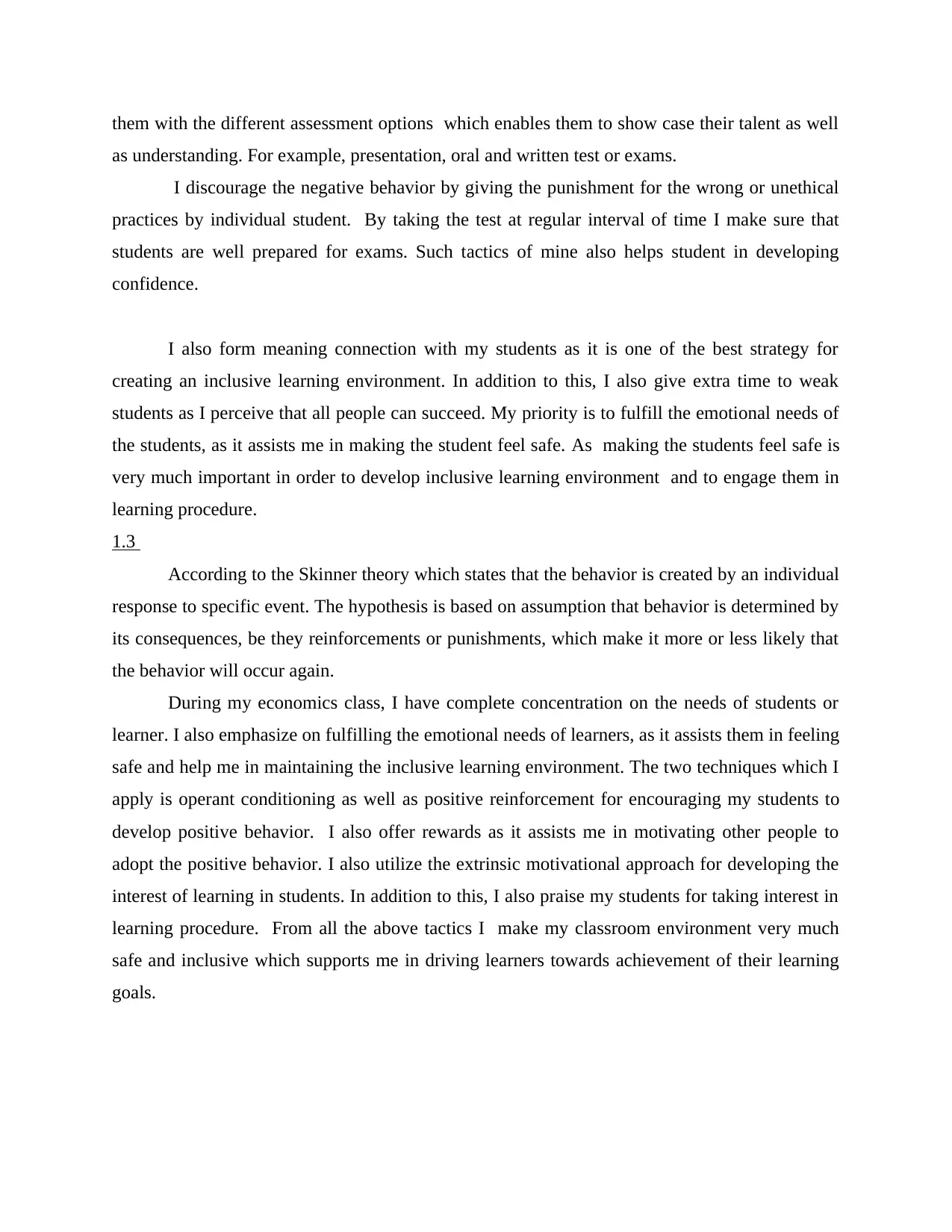
them with the different assessment options which enables them to show case their talent as well
as understanding. For example, presentation, oral and written test or exams.
I discourage the negative behavior by giving the punishment for the wrong or unethical
practices by individual student. By taking the test at regular interval of time I make sure that
students are well prepared for exams. Such tactics of mine also helps student in developing
confidence.
I also form meaning connection with my students as it is one of the best strategy for
creating an inclusive learning environment. In addition to this, I also give extra time to weak
students as I perceive that all people can succeed. My priority is to fulfill the emotional needs of
the students, as it assists me in making the student feel safe. As making the students feel safe is
very much important in order to develop inclusive learning environment and to engage them in
learning procedure.
1.3
According to the Skinner theory which states that the behavior is created by an individual
response to specific event. The hypothesis is based on assumption that behavior is determined by
its consequences, be they reinforcements or punishments, which make it more or less likely that
the behavior will occur again.
During my economics class, I have complete concentration on the needs of students or
learner. I also emphasize on fulfilling the emotional needs of learners, as it assists them in feeling
safe and help me in maintaining the inclusive learning environment. The two techniques which I
apply is operant conditioning as well as positive reinforcement for encouraging my students to
develop positive behavior. I also offer rewards as it assists me in motivating other people to
adopt the positive behavior. I also utilize the extrinsic motivational approach for developing the
interest of learning in students. In addition to this, I also praise my students for taking interest in
learning procedure. From all the above tactics I make my classroom environment very much
safe and inclusive which supports me in driving learners towards achievement of their learning
goals.
as understanding. For example, presentation, oral and written test or exams.
I discourage the negative behavior by giving the punishment for the wrong or unethical
practices by individual student. By taking the test at regular interval of time I make sure that
students are well prepared for exams. Such tactics of mine also helps student in developing
confidence.
I also form meaning connection with my students as it is one of the best strategy for
creating an inclusive learning environment. In addition to this, I also give extra time to weak
students as I perceive that all people can succeed. My priority is to fulfill the emotional needs of
the students, as it assists me in making the student feel safe. As making the students feel safe is
very much important in order to develop inclusive learning environment and to engage them in
learning procedure.
1.3
According to the Skinner theory which states that the behavior is created by an individual
response to specific event. The hypothesis is based on assumption that behavior is determined by
its consequences, be they reinforcements or punishments, which make it more or less likely that
the behavior will occur again.
During my economics class, I have complete concentration on the needs of students or
learner. I also emphasize on fulfilling the emotional needs of learners, as it assists them in feeling
safe and help me in maintaining the inclusive learning environment. The two techniques which I
apply is operant conditioning as well as positive reinforcement for encouraging my students to
develop positive behavior. I also offer rewards as it assists me in motivating other people to
adopt the positive behavior. I also utilize the extrinsic motivational approach for developing the
interest of learning in students. In addition to this, I also praise my students for taking interest in
learning procedure. From all the above tactics I make my classroom environment very much
safe and inclusive which supports me in driving learners towards achievement of their learning
goals.
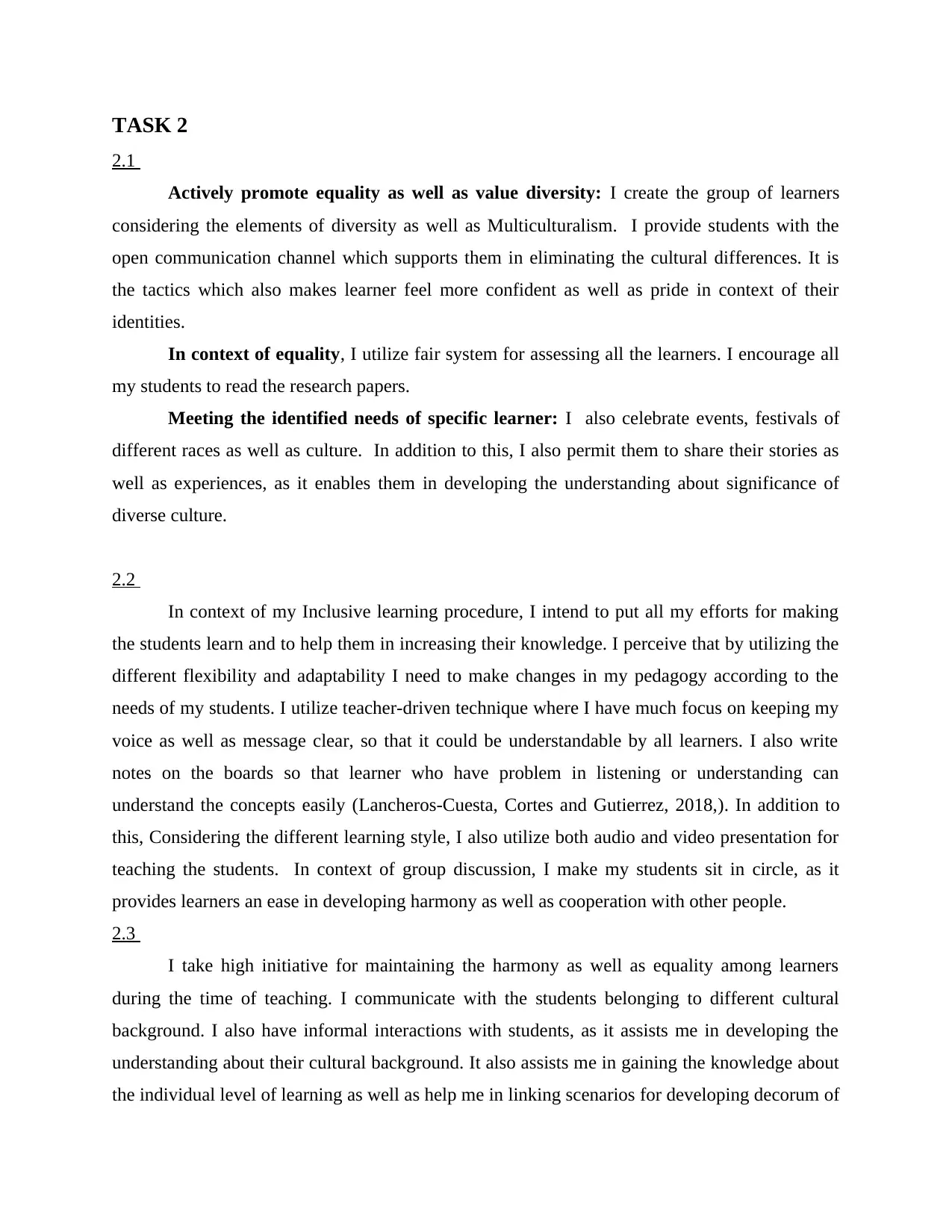
TASK 2
2.1
Actively promote equality as well as value diversity: I create the group of learners
considering the elements of diversity as well as Multiculturalism. I provide students with the
open communication channel which supports them in eliminating the cultural differences. It is
the tactics which also makes learner feel more confident as well as pride in context of their
identities.
In context of equality, I utilize fair system for assessing all the learners. I encourage all
my students to read the research papers.
Meeting the identified needs of specific learner: I also celebrate events, festivals of
different races as well as culture. In addition to this, I also permit them to share their stories as
well as experiences, as it enables them in developing the understanding about significance of
diverse culture.
2.2
In context of my Inclusive learning procedure, I intend to put all my efforts for making
the students learn and to help them in increasing their knowledge. I perceive that by utilizing the
different flexibility and adaptability I need to make changes in my pedagogy according to the
needs of my students. I utilize teacher-driven technique where I have much focus on keeping my
voice as well as message clear, so that it could be understandable by all learners. I also write
notes on the boards so that learner who have problem in listening or understanding can
understand the concepts easily (Lancheros-Cuesta, Cortes and Gutierrez, 2018,). In addition to
this, Considering the different learning style, I also utilize both audio and video presentation for
teaching the students. In context of group discussion, I make my students sit in circle, as it
provides learners an ease in developing harmony as well as cooperation with other people.
2.3
I take high initiative for maintaining the harmony as well as equality among learners
during the time of teaching. I communicate with the students belonging to different cultural
background. I also have informal interactions with students, as it assists me in developing the
understanding about their cultural background. It also assists me in gaining the knowledge about
the individual level of learning as well as help me in linking scenarios for developing decorum of
2.1
Actively promote equality as well as value diversity: I create the group of learners
considering the elements of diversity as well as Multiculturalism. I provide students with the
open communication channel which supports them in eliminating the cultural differences. It is
the tactics which also makes learner feel more confident as well as pride in context of their
identities.
In context of equality, I utilize fair system for assessing all the learners. I encourage all
my students to read the research papers.
Meeting the identified needs of specific learner: I also celebrate events, festivals of
different races as well as culture. In addition to this, I also permit them to share their stories as
well as experiences, as it enables them in developing the understanding about significance of
diverse culture.
2.2
In context of my Inclusive learning procedure, I intend to put all my efforts for making
the students learn and to help them in increasing their knowledge. I perceive that by utilizing the
different flexibility and adaptability I need to make changes in my pedagogy according to the
needs of my students. I utilize teacher-driven technique where I have much focus on keeping my
voice as well as message clear, so that it could be understandable by all learners. I also write
notes on the boards so that learner who have problem in listening or understanding can
understand the concepts easily (Lancheros-Cuesta, Cortes and Gutierrez, 2018,). In addition to
this, Considering the different learning style, I also utilize both audio and video presentation for
teaching the students. In context of group discussion, I make my students sit in circle, as it
provides learners an ease in developing harmony as well as cooperation with other people.
2.3
I take high initiative for maintaining the harmony as well as equality among learners
during the time of teaching. I communicate with the students belonging to different cultural
background. I also have informal interactions with students, as it assists me in developing the
understanding about their cultural background. It also assists me in gaining the knowledge about
the individual level of learning as well as help me in linking scenarios for developing decorum of
⊘ This is a preview!⊘
Do you want full access?
Subscribe today to unlock all pages.

Trusted by 1+ million students worldwide
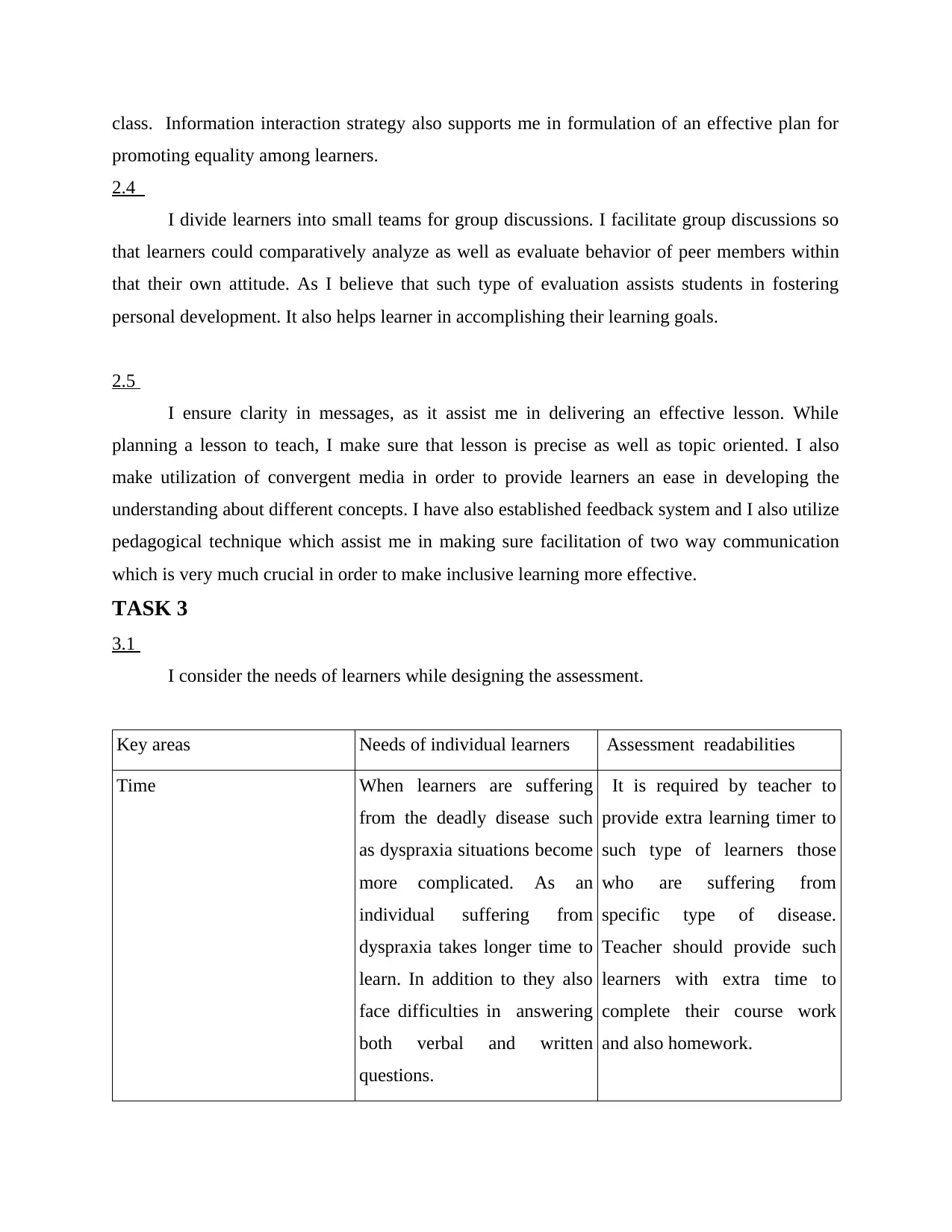
class. Information interaction strategy also supports me in formulation of an effective plan for
promoting equality among learners.
2.4
I divide learners into small teams for group discussions. I facilitate group discussions so
that learners could comparatively analyze as well as evaluate behavior of peer members within
that their own attitude. As I believe that such type of evaluation assists students in fostering
personal development. It also helps learner in accomplishing their learning goals.
2.5
I ensure clarity in messages, as it assist me in delivering an effective lesson. While
planning a lesson to teach, I make sure that lesson is precise as well as topic oriented. I also
make utilization of convergent media in order to provide learners an ease in developing the
understanding about different concepts. I have also established feedback system and I also utilize
pedagogical technique which assist me in making sure facilitation of two way communication
which is very much crucial in order to make inclusive learning more effective.
TASK 3
3.1
I consider the needs of learners while designing the assessment.
Key areas Needs of individual learners Assessment readabilities
Time When learners are suffering
from the deadly disease such
as dyspraxia situations become
more complicated. As an
individual suffering from
dyspraxia takes longer time to
learn. In addition to they also
face difficulties in answering
both verbal and written
questions.
It is required by teacher to
provide extra learning timer to
such type of learners those
who are suffering from
specific type of disease.
Teacher should provide such
learners with extra time to
complete their course work
and also homework.
promoting equality among learners.
2.4
I divide learners into small teams for group discussions. I facilitate group discussions so
that learners could comparatively analyze as well as evaluate behavior of peer members within
that their own attitude. As I believe that such type of evaluation assists students in fostering
personal development. It also helps learner in accomplishing their learning goals.
2.5
I ensure clarity in messages, as it assist me in delivering an effective lesson. While
planning a lesson to teach, I make sure that lesson is precise as well as topic oriented. I also
make utilization of convergent media in order to provide learners an ease in developing the
understanding about different concepts. I have also established feedback system and I also utilize
pedagogical technique which assist me in making sure facilitation of two way communication
which is very much crucial in order to make inclusive learning more effective.
TASK 3
3.1
I consider the needs of learners while designing the assessment.
Key areas Needs of individual learners Assessment readabilities
Time When learners are suffering
from the deadly disease such
as dyspraxia situations become
more complicated. As an
individual suffering from
dyspraxia takes longer time to
learn. In addition to they also
face difficulties in answering
both verbal and written
questions.
It is required by teacher to
provide extra learning timer to
such type of learners those
who are suffering from
specific type of disease.
Teacher should provide such
learners with extra time to
complete their course work
and also homework.
Paraphrase This Document
Need a fresh take? Get an instant paraphrase of this document with our AI Paraphraser
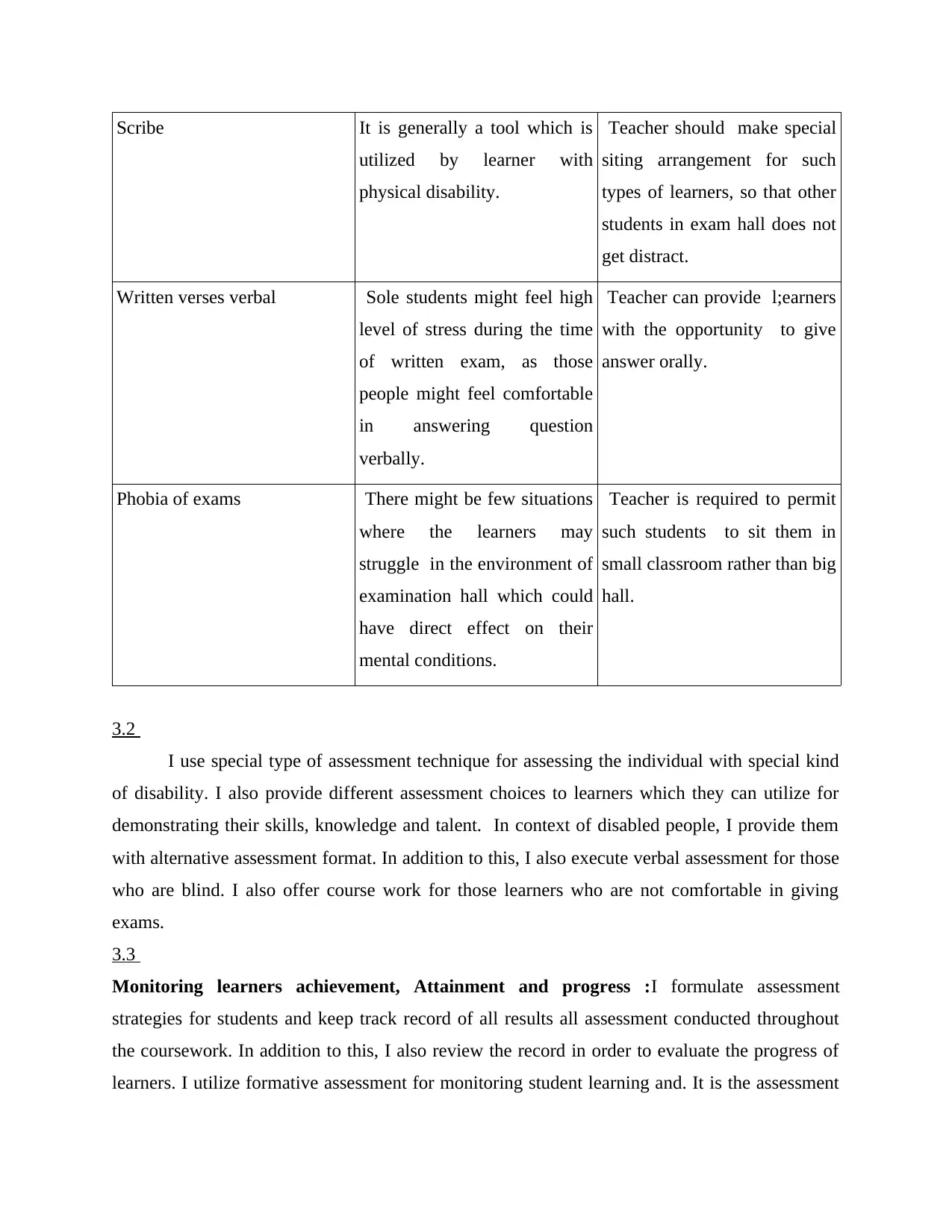
Scribe It is generally a tool which is
utilized by learner with
physical disability.
Teacher should make special
siting arrangement for such
types of learners, so that other
students in exam hall does not
get distract.
Written verses verbal Sole students might feel high
level of stress during the time
of written exam, as those
people might feel comfortable
in answering question
verbally.
Teacher can provide l;earners
with the opportunity to give
answer orally.
Phobia of exams There might be few situations
where the learners may
struggle in the environment of
examination hall which could
have direct effect on their
mental conditions.
Teacher is required to permit
such students to sit them in
small classroom rather than big
hall.
3.2
I use special type of assessment technique for assessing the individual with special kind
of disability. I also provide different assessment choices to learners which they can utilize for
demonstrating their skills, knowledge and talent. In context of disabled people, I provide them
with alternative assessment format. In addition to this, I also execute verbal assessment for those
who are blind. I also offer course work for those learners who are not comfortable in giving
exams.
3.3
Monitoring learners achievement, Attainment and progress :I formulate assessment
strategies for students and keep track record of all results all assessment conducted throughout
the coursework. In addition to this, I also review the record in order to evaluate the progress of
learners. I utilize formative assessment for monitoring student learning and. It is the assessment
utilized by learner with
physical disability.
Teacher should make special
siting arrangement for such
types of learners, so that other
students in exam hall does not
get distract.
Written verses verbal Sole students might feel high
level of stress during the time
of written exam, as those
people might feel comfortable
in answering question
verbally.
Teacher can provide l;earners
with the opportunity to give
answer orally.
Phobia of exams There might be few situations
where the learners may
struggle in the environment of
examination hall which could
have direct effect on their
mental conditions.
Teacher is required to permit
such students to sit them in
small classroom rather than big
hall.
3.2
I use special type of assessment technique for assessing the individual with special kind
of disability. I also provide different assessment choices to learners which they can utilize for
demonstrating their skills, knowledge and talent. In context of disabled people, I provide them
with alternative assessment format. In addition to this, I also execute verbal assessment for those
who are blind. I also offer course work for those learners who are not comfortable in giving
exams.
3.3
Monitoring learners achievement, Attainment and progress :I formulate assessment
strategies for students and keep track record of all results all assessment conducted throughout
the coursework. In addition to this, I also review the record in order to evaluate the progress of
learners. I utilize formative assessment for monitoring student learning and. It is the assessment
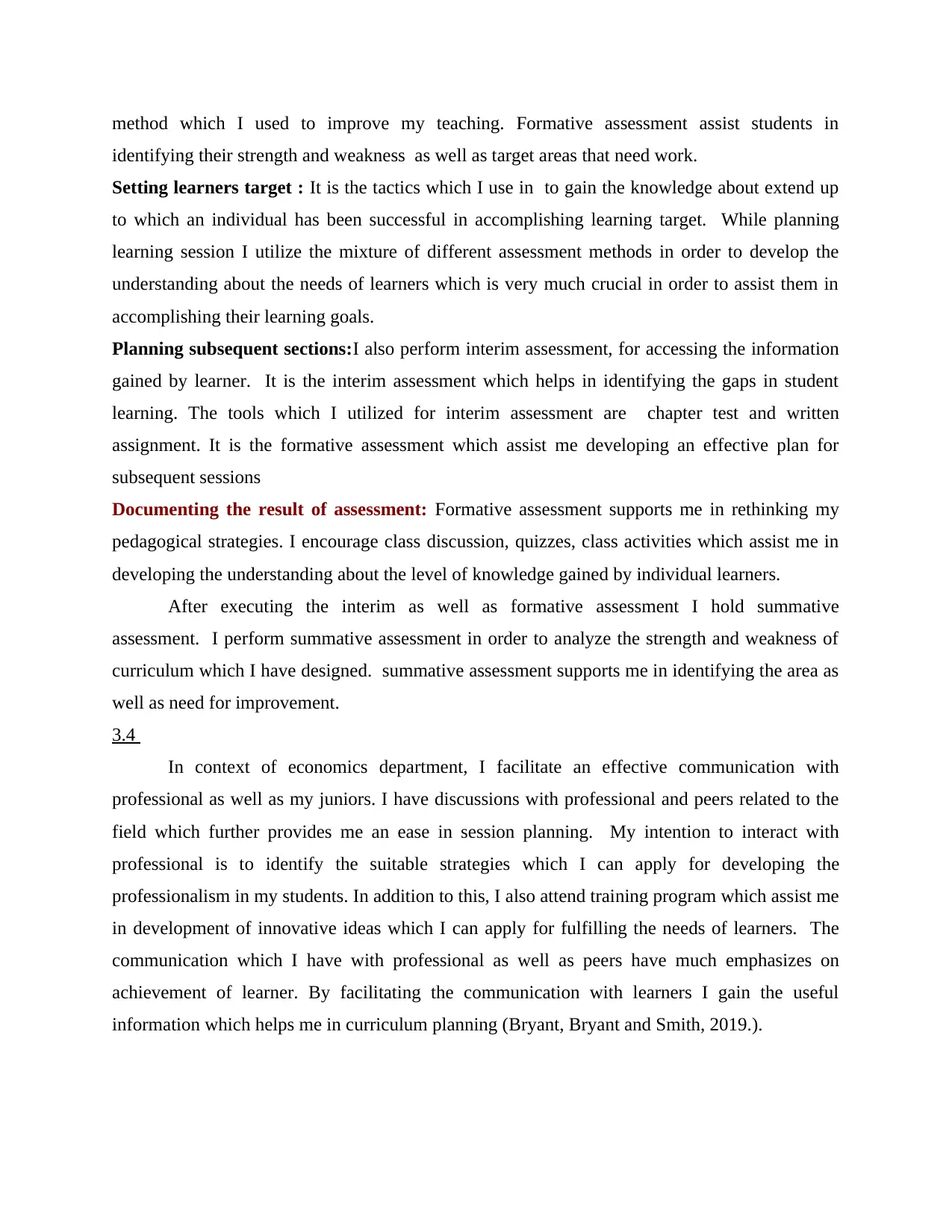
method which I used to improve my teaching. Formative assessment assist students in
identifying their strength and weakness as well as target areas that need work.
Setting learners target : It is the tactics which I use in to gain the knowledge about extend up
to which an individual has been successful in accomplishing learning target. While planning
learning session I utilize the mixture of different assessment methods in order to develop the
understanding about the needs of learners which is very much crucial in order to assist them in
accomplishing their learning goals.
Planning subsequent sections:I also perform interim assessment, for accessing the information
gained by learner. It is the interim assessment which helps in identifying the gaps in student
learning. The tools which I utilized for interim assessment are chapter test and written
assignment. It is the formative assessment which assist me developing an effective plan for
subsequent sessions
Documenting the result of assessment: Formative assessment supports me in rethinking my
pedagogical strategies. I encourage class discussion, quizzes, class activities which assist me in
developing the understanding about the level of knowledge gained by individual learners.
After executing the interim as well as formative assessment I hold summative
assessment. I perform summative assessment in order to analyze the strength and weakness of
curriculum which I have designed. summative assessment supports me in identifying the area as
well as need for improvement.
3.4
In context of economics department, I facilitate an effective communication with
professional as well as my juniors. I have discussions with professional and peers related to the
field which further provides me an ease in session planning. My intention to interact with
professional is to identify the suitable strategies which I can apply for developing the
professionalism in my students. In addition to this, I also attend training program which assist me
in development of innovative ideas which I can apply for fulfilling the needs of learners. The
communication which I have with professional as well as peers have much emphasizes on
achievement of learner. By facilitating the communication with learners I gain the useful
information which helps me in curriculum planning (Bryant, Bryant and Smith, 2019.).
identifying their strength and weakness as well as target areas that need work.
Setting learners target : It is the tactics which I use in to gain the knowledge about extend up
to which an individual has been successful in accomplishing learning target. While planning
learning session I utilize the mixture of different assessment methods in order to develop the
understanding about the needs of learners which is very much crucial in order to assist them in
accomplishing their learning goals.
Planning subsequent sections:I also perform interim assessment, for accessing the information
gained by learner. It is the interim assessment which helps in identifying the gaps in student
learning. The tools which I utilized for interim assessment are chapter test and written
assignment. It is the formative assessment which assist me developing an effective plan for
subsequent sessions
Documenting the result of assessment: Formative assessment supports me in rethinking my
pedagogical strategies. I encourage class discussion, quizzes, class activities which assist me in
developing the understanding about the level of knowledge gained by individual learners.
After executing the interim as well as formative assessment I hold summative
assessment. I perform summative assessment in order to analyze the strength and weakness of
curriculum which I have designed. summative assessment supports me in identifying the area as
well as need for improvement.
3.4
In context of economics department, I facilitate an effective communication with
professional as well as my juniors. I have discussions with professional and peers related to the
field which further provides me an ease in session planning. My intention to interact with
professional is to identify the suitable strategies which I can apply for developing the
professionalism in my students. In addition to this, I also attend training program which assist me
in development of innovative ideas which I can apply for fulfilling the needs of learners. The
communication which I have with professional as well as peers have much emphasizes on
achievement of learner. By facilitating the communication with learners I gain the useful
information which helps me in curriculum planning (Bryant, Bryant and Smith, 2019.).
⊘ This is a preview!⊘
Do you want full access?
Subscribe today to unlock all pages.

Trusted by 1+ million students worldwide
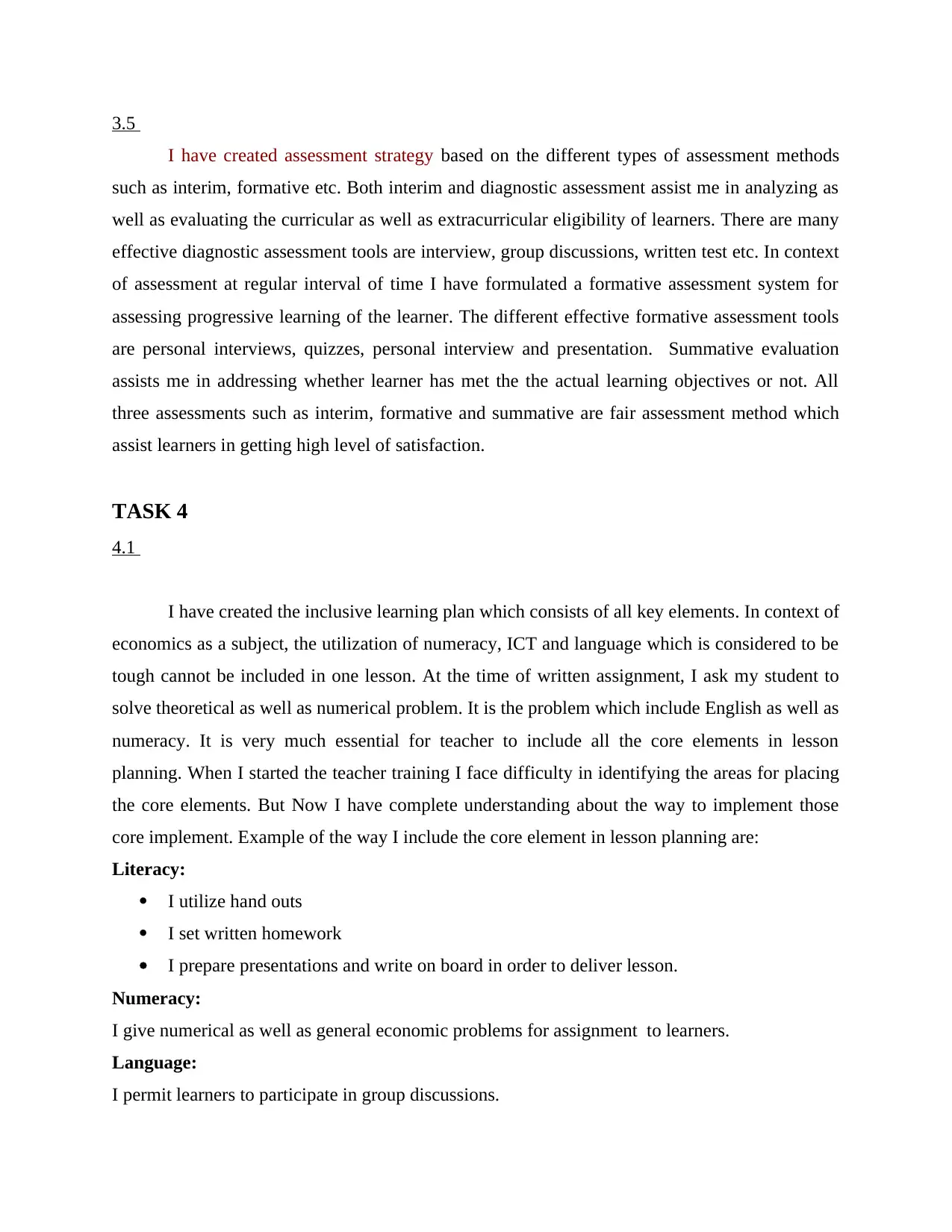
3.5
I have created assessment strategy based on the different types of assessment methods
such as interim, formative etc. Both interim and diagnostic assessment assist me in analyzing as
well as evaluating the curricular as well as extracurricular eligibility of learners. There are many
effective diagnostic assessment tools are interview, group discussions, written test etc. In context
of assessment at regular interval of time I have formulated a formative assessment system for
assessing progressive learning of the learner. The different effective formative assessment tools
are personal interviews, quizzes, personal interview and presentation. Summative evaluation
assists me in addressing whether learner has met the the actual learning objectives or not. All
three assessments such as interim, formative and summative are fair assessment method which
assist learners in getting high level of satisfaction.
TASK 4
4.1
I have created the inclusive learning plan which consists of all key elements. In context of
economics as a subject, the utilization of numeracy, ICT and language which is considered to be
tough cannot be included in one lesson. At the time of written assignment, I ask my student to
solve theoretical as well as numerical problem. It is the problem which include English as well as
numeracy. It is very much essential for teacher to include all the core elements in lesson
planning. When I started the teacher training I face difficulty in identifying the areas for placing
the core elements. But Now I have complete understanding about the way to implement those
core implement. Example of the way I include the core element in lesson planning are:
Literacy:
I utilize hand outs
I set written homework
I prepare presentations and write on board in order to deliver lesson.
Numeracy:
I give numerical as well as general economic problems for assignment to learners.
Language:
I permit learners to participate in group discussions.
I have created assessment strategy based on the different types of assessment methods
such as interim, formative etc. Both interim and diagnostic assessment assist me in analyzing as
well as evaluating the curricular as well as extracurricular eligibility of learners. There are many
effective diagnostic assessment tools are interview, group discussions, written test etc. In context
of assessment at regular interval of time I have formulated a formative assessment system for
assessing progressive learning of the learner. The different effective formative assessment tools
are personal interviews, quizzes, personal interview and presentation. Summative evaluation
assists me in addressing whether learner has met the the actual learning objectives or not. All
three assessments such as interim, formative and summative are fair assessment method which
assist learners in getting high level of satisfaction.
TASK 4
4.1
I have created the inclusive learning plan which consists of all key elements. In context of
economics as a subject, the utilization of numeracy, ICT and language which is considered to be
tough cannot be included in one lesson. At the time of written assignment, I ask my student to
solve theoretical as well as numerical problem. It is the problem which include English as well as
numeracy. It is very much essential for teacher to include all the core elements in lesson
planning. When I started the teacher training I face difficulty in identifying the areas for placing
the core elements. But Now I have complete understanding about the way to implement those
core implement. Example of the way I include the core element in lesson planning are:
Literacy:
I utilize hand outs
I set written homework
I prepare presentations and write on board in order to deliver lesson.
Numeracy:
I give numerical as well as general economic problems for assignment to learners.
Language:
I permit learners to participate in group discussions.
Paraphrase This Document
Need a fresh take? Get an instant paraphrase of this document with our AI Paraphraser
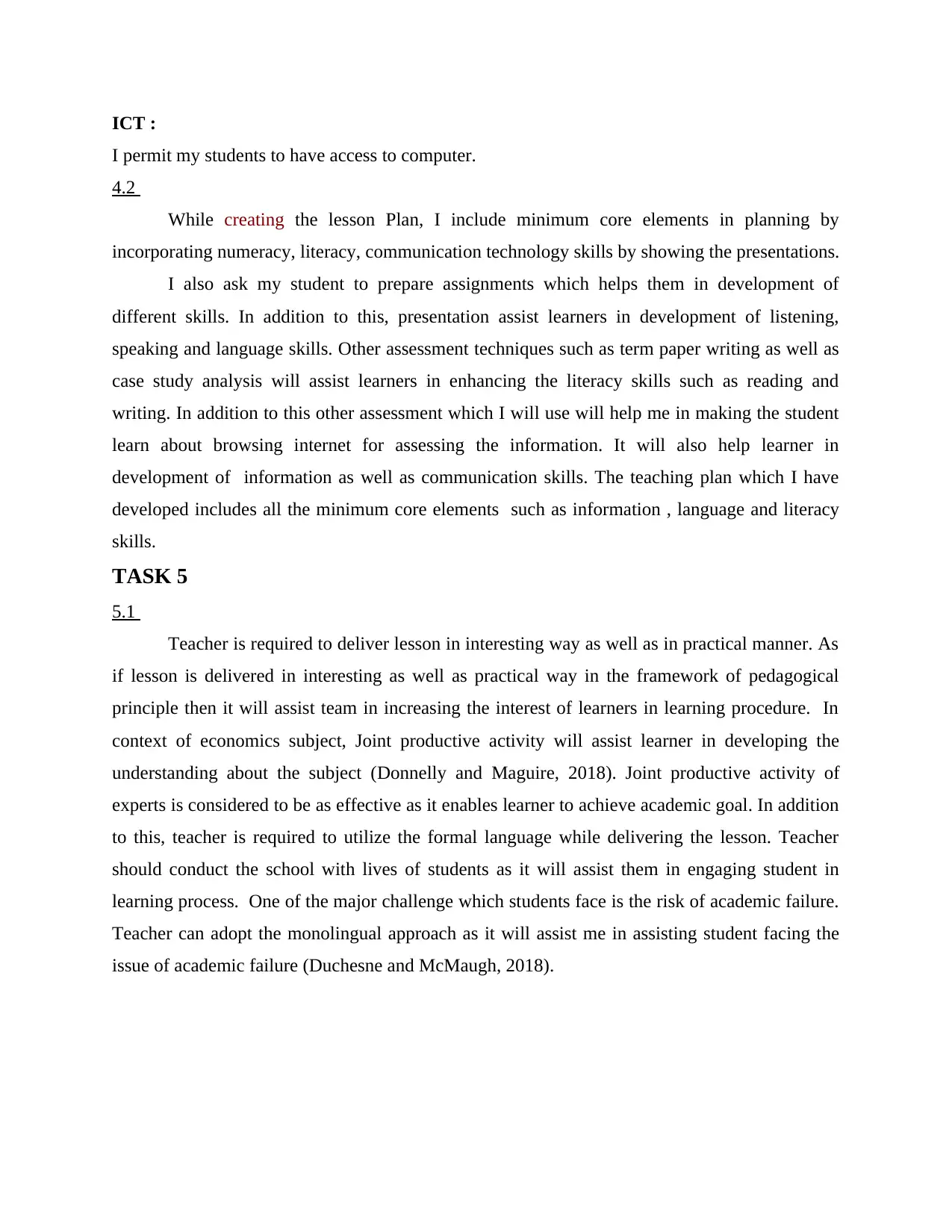
ICT :
I permit my students to have access to computer.
4.2
While creating the lesson Plan, I include minimum core elements in planning by
incorporating numeracy, literacy, communication technology skills by showing the presentations.
I also ask my student to prepare assignments which helps them in development of
different skills. In addition to this, presentation assist learners in development of listening,
speaking and language skills. Other assessment techniques such as term paper writing as well as
case study analysis will assist learners in enhancing the literacy skills such as reading and
writing. In addition to this other assessment which I will use will help me in making the student
learn about browsing internet for assessing the information. It will also help learner in
development of information as well as communication skills. The teaching plan which I have
developed includes all the minimum core elements such as information , language and literacy
skills.
TASK 5
5.1
Teacher is required to deliver lesson in interesting way as well as in practical manner. As
if lesson is delivered in interesting as well as practical way in the framework of pedagogical
principle then it will assist team in increasing the interest of learners in learning procedure. In
context of economics subject, Joint productive activity will assist learner in developing the
understanding about the subject (Donnelly and Maguire, 2018). Joint productive activity of
experts is considered to be as effective as it enables learner to achieve academic goal. In addition
to this, teacher is required to utilize the formal language while delivering the lesson. Teacher
should conduct the school with lives of students as it will assist them in engaging student in
learning process. One of the major challenge which students face is the risk of academic failure.
Teacher can adopt the monolingual approach as it will assist me in assisting student facing the
issue of academic failure (Duchesne and McMaugh, 2018).
I permit my students to have access to computer.
4.2
While creating the lesson Plan, I include minimum core elements in planning by
incorporating numeracy, literacy, communication technology skills by showing the presentations.
I also ask my student to prepare assignments which helps them in development of
different skills. In addition to this, presentation assist learners in development of listening,
speaking and language skills. Other assessment techniques such as term paper writing as well as
case study analysis will assist learners in enhancing the literacy skills such as reading and
writing. In addition to this other assessment which I will use will help me in making the student
learn about browsing internet for assessing the information. It will also help learner in
development of information as well as communication skills. The teaching plan which I have
developed includes all the minimum core elements such as information , language and literacy
skills.
TASK 5
5.1
Teacher is required to deliver lesson in interesting way as well as in practical manner. As
if lesson is delivered in interesting as well as practical way in the framework of pedagogical
principle then it will assist team in increasing the interest of learners in learning procedure. In
context of economics subject, Joint productive activity will assist learner in developing the
understanding about the subject (Donnelly and Maguire, 2018). Joint productive activity of
experts is considered to be as effective as it enables learner to achieve academic goal. In addition
to this, teacher is required to utilize the formal language while delivering the lesson. Teacher
should conduct the school with lives of students as it will assist them in engaging student in
learning process. One of the major challenge which students face is the risk of academic failure.
Teacher can adopt the monolingual approach as it will assist me in assisting student facing the
issue of academic failure (Duchesne and McMaugh, 2018).
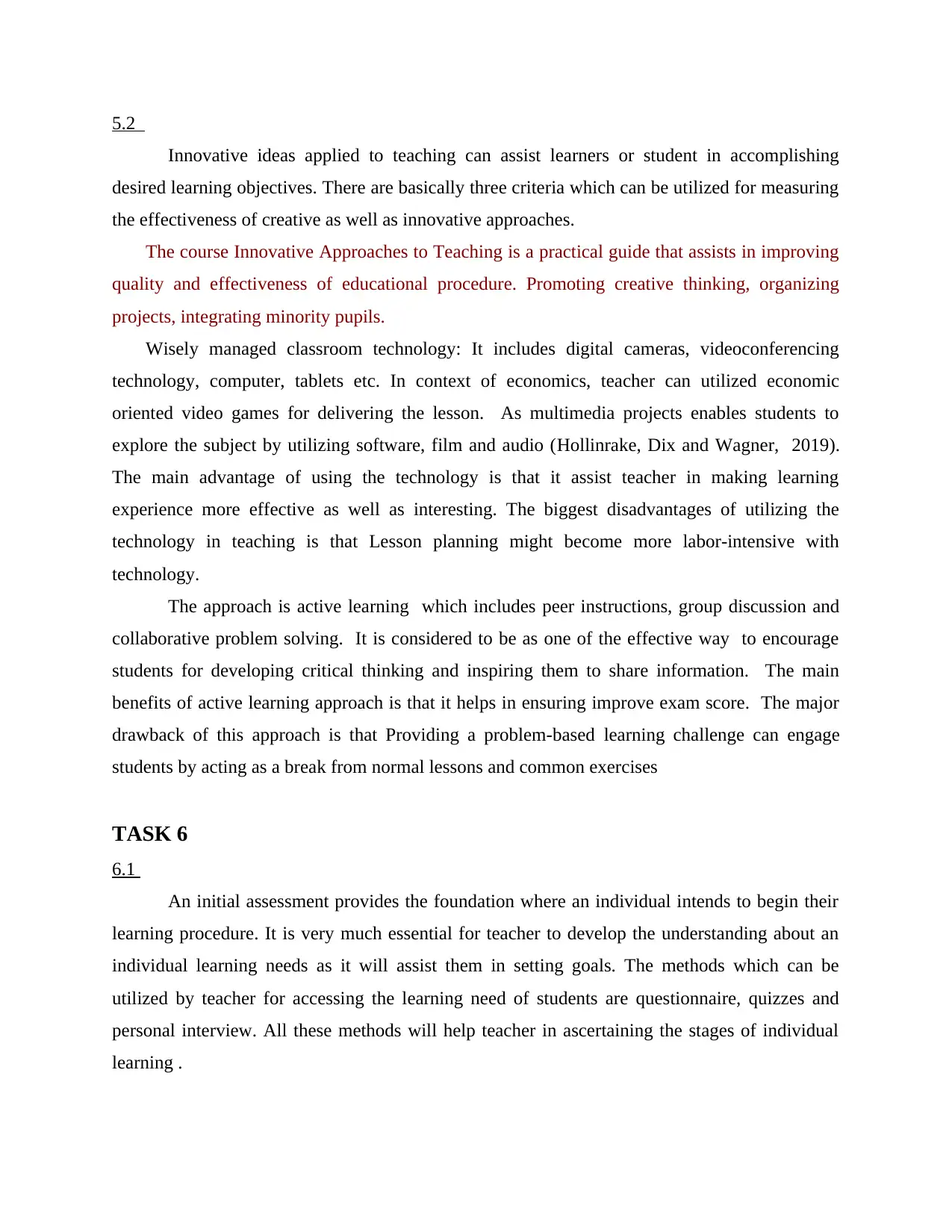
5.2
Innovative ideas applied to teaching can assist learners or student in accomplishing
desired learning objectives. There are basically three criteria which can be utilized for measuring
the effectiveness of creative as well as innovative approaches.
The course Innovative Approaches to Teaching is a practical guide that assists in improving
quality and effectiveness of educational procedure. Promoting creative thinking, organizing
projects, integrating minority pupils.
Wisely managed classroom technology: It includes digital cameras, videoconferencing
technology, computer, tablets etc. In context of economics, teacher can utilized economic
oriented video games for delivering the lesson. As multimedia projects enables students to
explore the subject by utilizing software, film and audio (Hollinrake, Dix and Wagner, 2019).
The main advantage of using the technology is that it assist teacher in making learning
experience more effective as well as interesting. The biggest disadvantages of utilizing the
technology in teaching is that Lesson planning might become more labor-intensive with
technology.
The approach is active learning which includes peer instructions, group discussion and
collaborative problem solving. It is considered to be as one of the effective way to encourage
students for developing critical thinking and inspiring them to share information. The main
benefits of active learning approach is that it helps in ensuring improve exam score. The major
drawback of this approach is that Providing a problem-based learning challenge can engage
students by acting as a break from normal lessons and common exercises
TASK 6
6.1
An initial assessment provides the foundation where an individual intends to begin their
learning procedure. It is very much essential for teacher to develop the understanding about an
individual learning needs as it will assist them in setting goals. The methods which can be
utilized by teacher for accessing the learning need of students are questionnaire, quizzes and
personal interview. All these methods will help teacher in ascertaining the stages of individual
learning .
Innovative ideas applied to teaching can assist learners or student in accomplishing
desired learning objectives. There are basically three criteria which can be utilized for measuring
the effectiveness of creative as well as innovative approaches.
The course Innovative Approaches to Teaching is a practical guide that assists in improving
quality and effectiveness of educational procedure. Promoting creative thinking, organizing
projects, integrating minority pupils.
Wisely managed classroom technology: It includes digital cameras, videoconferencing
technology, computer, tablets etc. In context of economics, teacher can utilized economic
oriented video games for delivering the lesson. As multimedia projects enables students to
explore the subject by utilizing software, film and audio (Hollinrake, Dix and Wagner, 2019).
The main advantage of using the technology is that it assist teacher in making learning
experience more effective as well as interesting. The biggest disadvantages of utilizing the
technology in teaching is that Lesson planning might become more labor-intensive with
technology.
The approach is active learning which includes peer instructions, group discussion and
collaborative problem solving. It is considered to be as one of the effective way to encourage
students for developing critical thinking and inspiring them to share information. The main
benefits of active learning approach is that it helps in ensuring improve exam score. The major
drawback of this approach is that Providing a problem-based learning challenge can engage
students by acting as a break from normal lessons and common exercises
TASK 6
6.1
An initial assessment provides the foundation where an individual intends to begin their
learning procedure. It is very much essential for teacher to develop the understanding about an
individual learning needs as it will assist them in setting goals. The methods which can be
utilized by teacher for accessing the learning need of students are questionnaire, quizzes and
personal interview. All these methods will help teacher in ascertaining the stages of individual
learning .
⊘ This is a preview!⊘
Do you want full access?
Subscribe today to unlock all pages.

Trusted by 1+ million students worldwide
1 out of 18
Related Documents
Your All-in-One AI-Powered Toolkit for Academic Success.
+13062052269
info@desklib.com
Available 24*7 on WhatsApp / Email
![[object Object]](/_next/static/media/star-bottom.7253800d.svg)
Unlock your academic potential
Copyright © 2020–2025 A2Z Services. All Rights Reserved. Developed and managed by ZUCOL.



